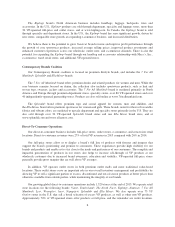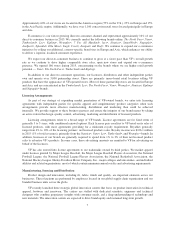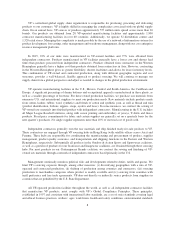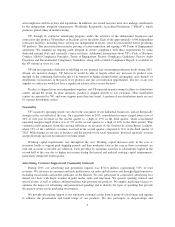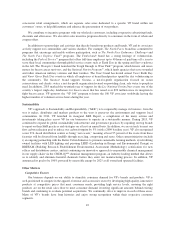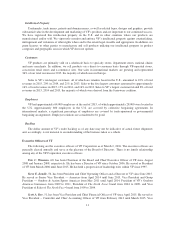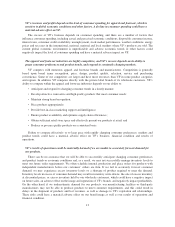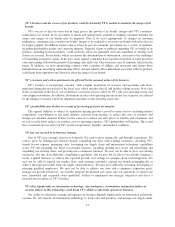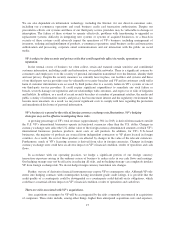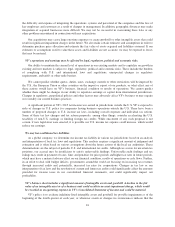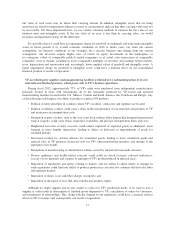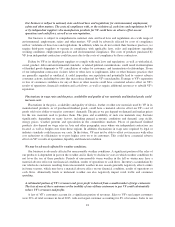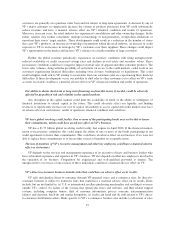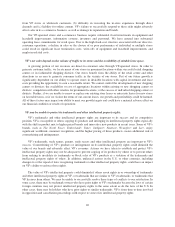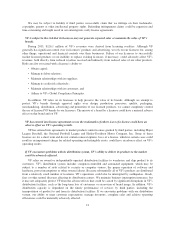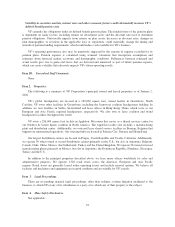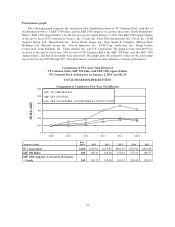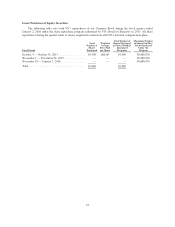North Face 2015 Annual Report Download - page 29
Download and view the complete annual report
Please find page 29 of the 2015 North Face annual report below. You can navigate through the pages in the report by either clicking on the pages listed below, or by using the keyword search tool below to find specific information within the annual report.We are also dependent on information technology, including the Internet, for our direct-to-consumer sales,
including our e-commerce operations and retail business credit card transaction authorization. Despite our
preventative efforts, our systems and those of our third-party service providers may be vulnerable to damage or
interruption. The failure of these systems to operate effectively, problems with transitioning to upgraded or
replacement systems, difficulty in integrating new systems or systems of acquired businesses, or a breach in
security of these systems could adversely impact the operations of VF’s business, including management of
inventory, ordering and replenishment of products, e-commerce operations, retail business credit card transaction
authorization and processing, corporate email communications and our interaction with the public on social
media.
VF is subject to data security and privacy risks that could negatively affect its results, operations or
reputation.
In the normal course of business we often collect, retain and transmit certain sensitive and confidential
customer information, including credit card information, over public networks. There is a significant concern by
consumers and employees over the security of personal information transmitted over the Internet, identity theft
and user privacy. Despite the security measures we currently have in place, our facilities and systems and those
of our third-party service providers may be vulnerable to security breaches and VF and its customers could suffer
harm if customer information were accessed by third parties due to a security failure in VF’s systems or one of
our third-party service providers. It could require significant expenditures to remediate any such failure or
breach, severely damage our reputation and our relationships with customers, and expose us to risks of litigation
and liability. In addition, as a result of recent security breaches at a number of prominent retailers, the media and
public scrutiny of information security and privacy has become more intense and the regulatory environment has
become more uncertain. As a result, we may incur significant costs to comply with laws regarding the protection
and unauthorized disclosure of personal information.
VF’s business is exposed to the risks of foreign currency exchange rate fluctuations. VF’s hedging
strategies may not be effective in mitigating those risks.
A growing percentage of VF’s total revenues (approximately 36% in 2015) is derived from markets outside
the U.S. VF’s international businesses operate in functional currencies other than the U.S. dollar. Changes in
currency exchange rates affect the U.S. dollar value of the foreign currency-denominated amounts at which VF’s
international businesses purchase products, incur costs or sell products. In addition, for VF’s U.S.-based
businesses, the majority of products are sourced from independent contractors or VF plants located in foreign
countries. As a result, the cost of these products are affected by changes in the value of the relevant currencies.
Furthermore, much of VF’s licensing revenue is derived from sales in foreign currencies. Changes in foreign
currency exchange rates could have an adverse impact on VF’s financial condition, results of operations and cash
flows.
In accordance with our operating practices, we hedge a significant portion of our foreign currency
transaction exposures arising in the ordinary course of business to reduce risks in our cash flows and earnings.
Our hedging strategy may not be effective in reducing all risks, and no hedging strategy can completely insulate
VF from foreign exchange risk. We do not hedge foreign currency translation rate changes.
Further, our use of derivative financial instruments may expose VF to counterparty risks. Although VF only
enters into hedging contracts with counterparties having investment grade credit ratings, it is possible that the
credit quality of a counterparty could be downgraded or a counterparty could default on its obligations, which
could have a material adverse impact on VF’s financial condition, results of operations and cash flows.
There are risks associated with VF’s acquisitions.
Any acquisitions or mergers by VF will be accompanied by the risks commonly encountered in acquisitions
of companies. These risks include, among other things, higher than anticipated acquisition costs and expenses,
15



